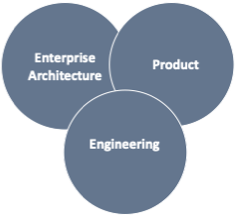The prime role of Engineering is to create products. Products in the sense that it is the 'something' that your company sells to your customers, and that they perceive value in.
Enterprise Architecture, Product & Engineering are at the heart of the company, and an essential part of the customer-centric organisation.

In a digitally transformed organisation, many the products will have a significant technology aspect, which, with the people and process associated with it, provides that customer value. In the case of digital systems, the approach to creating the technology part is very different to traditional IT.
Historically, the enormous time lag between requirements definition and subsequent technology delivery led to cancelled projects & dissatisfied stakeholders.
Requirements frequently changed during this lag time, the final product no longer meeting the newly-current needs.
The software development models of the day, led by the waterfall model, were not meeting the demand for speed and did not take advantage of just how quickly software could be altered.
The Agile Manifesto and the Twelve Principles of Agile Software of 2001 were the consequences of industry frustration, and are still entirely relevant today. They are essential to digital leadership.
The Agile Manifesto reads:
We are uncovering better ways of developing software by doing it and helping others do it. Through this work we have come to value:
- Individuals and interactions over processes and tools
- Working software over comprehensive documentation
- Customer collaboration over contract negotiation
- Responding to change over following a plan.
The term ‘engineering’ may describe our understanding of the world and ability to invent, design, and build things to solve problems and achieve practical goals. In our world we use engineering teams to create products, built within an enterprise architecture.
Engineers, as practitioners of engineering, are professionals who invent, design, build and test machines, complex systems and structures to fulfill functional requirements while considering the limitations imposed by practicality, regulation, safety and cost.
In a service organisation, where technology is part of every product, this capability is often fulfilled by IT. Our customer-centric organisation must have a competent engineering staff within the cross-functional teams who create the company's products, and these engineers are rarely part of an IT department.
Next:
We discuss how each major cross-functional capability works in a customer-centric world in these other posts:


Building a customer-centric digital organisation that is focused on delivering value to your customers needs new and agile ways of working. We explore this thinking in The Three Laws.


